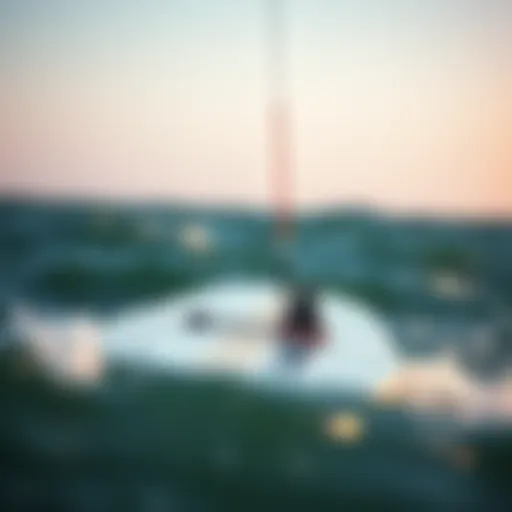Gulf of Mexico Weather Insights for Kiteboarding
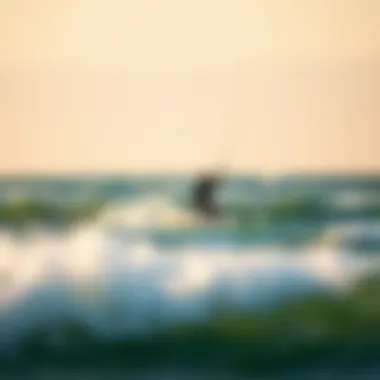

Intro
Kiteboarding in the Gulf of Mexico can be an exhilarating experience, offering wide-open spaces and a variety of wind conditions that cater to riders of all skill levels. However, to make the most of this stunning venue, it’s crucial to understand the weather dynamics at play. The Gulf's weather forecast map serves as a critical tool, providing valuable insights that kiteboarders need to plan their sessions wisely.
Understanding the specifics about wind patterns, temperatures, and potential storms can make the difference between a delightful day on the water and a soggy trip back to shore. This guide will peel back the layers of the Gulf of Mexico's weather system and highlight how varying conditions impact kiteboarding. With a blend of practical techniques and equipment recommendations, we aim to empower riders to navigate the unique weather landscape of the Gulf.
Let’s dive into the heart of the matter—how can the right knowledge transform your kiteboarding experience?
Techniques for Kiteboarding Enthusiasts
Beginner Techniques
For those new to kiteboarding, mastering the basics is essential. Here are some key techniques that beginners should focus on:
- Wind Awareness: Understand the wind direction and speed. The Gulf often has varying conditions, and it’s vital to know where the wind is coming from to control your kite effectively.
- Launching and Landing: Practice these two skills under the guidance of a seasoned instructor. A smooth launch can set the stage for a great ride, while understanding how to land correctly keeps you and your equipment safe.
- Riding Stance: Find your comfortable stance. Maintaining the right posture while kiteboarding helps with balance and control. Make sure to keep your knees bent and your weight distributed evenly.
Advanced Maneuvers
Once you’re past the beginner stage, you might be itching to learn some exciting tricks to impress your friends.
- Jumping: Getting air is a thrilling part of kiteboarding. Focus on your timing with the kite pull and the edge of your board to catch those sweet jumps.
- Board Tricks: Tricks like the Board Off can add flair to your riding. This requires practice, but your hard work will pay off with show-stopping tricks that will light up the beach.
- Tacking: Mastering tacks allows you to change direction smoothly, making it look effortless. A combination of edging and kite control is crucial here.
"The right technique not only looks good but also ensures a safer, more enjoyable ride."
Equipment Reviews
Kite Reviews
Selecting the right kite can profoundly impact your kiteboarding experience. Think about your skill level, wind conditions, and what you want out of your sessions. Some popular models among kiteboarders include:
- Core Kites - Nexus: Known for its versatility and performance, ideal for various conditions from moderate to strong winds.
- Slingshot - Rally: A good choice for freeriders looking to boost and perform tricks. This kite allows for great hang time and control.
- Naish - Pivot: This one is favored for its responsive steering and lift properties, making it suitable for riders who like to blend jumping with smooth transitions.
Board Reviews
Selecting the right board is equally important. The board should complement the kite to provide an overall smoother ride. Here are some notable options:
- Fanatic - Sky: This board is light and provides smooth riding across different conditions, especially in choppy waters.
- Airush - Diamond: This board is suited for flexibility and control, perfect for more aggressive styles of riding.
- Duotone - Whip: Known for its speed and directional stability, this board is great for those looking to maximize their performance and confidence in the water.
Navigating the winds and waves of the Gulf of Mexico requires both an understanding of the weather forecast and the right set of skills and equipment. By combining all these insights, kiteboarders can enhance their experience and focus on the thrill of riding.
For more about kiteboarding in different conditions, check out these useful resources:
Understanding the intricate details of weather patterns and equipment will undoubtedly elevate your time spent on the water.
Understanding the Gulf of Mexico Climate
The Gulf of Mexico presents some unique climatic challenges and opportunities for kiteboarding enthusiasts. Comprehending the weather dynamics in this region isn't just about enjoying a day on the water; it adds layers of safety and enjoyment to the experience. Understanding several key elements of the Gulf's climate can significantly influence your kiteboarding outcomes. Whether you're navigating a light breeze or battling fierce gusts, recognizing how local conditions vary will arm you with insights that enhance performance and ensure a safer outing.
Overview of Climate Zones
The Gulf of Mexico serves up a rich blend of climate zones. At the heart of it lies a humid subtropical climate, which shapes much of the environmental context. This means you can expect warm summers and mild winters. The temperature tends to hover around comfortable levels, but with high humidity, the muggy conditions can make days feel quite toasty.
The coastal areas experience a slightly different flair; oceanic influences lead to cooler breezes during summer while conversely warming in winter months. Hence, it’s helpful for kiteboarders to familiarize themselves with these zones, as they directly affect wind patterns and overall riding conditions.
For kiteboarding, knowing where to find the sweet spots can yield the best experience. This includes understanding which areas experience higher wind speeds, as well as recognizing microclimates that can spring up due to nearby topographical features, such as palm-lined beaches or significant structures like piers.
- Key zones to note include
- Coastal areas: Often windy due to their proximity to open water.
- Inland regions: Can experience calmer winds, ideal for beginners.
- Estuarine spots: Here, watch for shifts in wind caused by landscape changes.
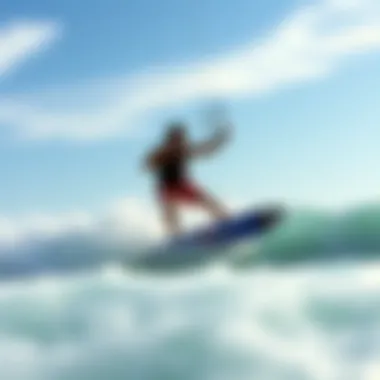

Seasonal Weather Variations
The Gulf experiences distinct seasonal variations, each bringing unique riding conditions that should be factored into any kiteboarding plan. As the seasons shift, so do wind patterns, precipitation, and temperature, each affecting kiteboarding prospects.
- Winter (December to February):
- Spring (March to May):
- Summer (June to August):
- Fall (September to November):
- Cooler temperatures with occasional cold fronts.
- Wind tends to be steadier, providing excellent conditions for experienced riders to take advantage.
- A mix of warm days and occasional thunderstorms.
- Winds can become quite variable, making it a mixed bag for kiteboarders.
- Hot and humid, with intense heat and unstable air.
- Afternoon thunderstorms are common; caution is needed as conditions can change fast.
- The hurricane season lingers, giving way to strong winds, but also bringing the threat of unpredictable storms.
- Early fall is still a prime time to hit the water before the cooler temperatures set in.
Recognizing these seasonal patterns is crucial for kiteboarders. They help determine when to hit the water, how to dress, and avoid any unwelcome surprises.
Important Note: Always keep an eye on real-time weather updates and forecasts. They can shift dramatically in the Gulf of Mexico, affecting not just your comfort but your safety out on the water.
Understanding these climate dynamics will not only shape your kiteboarding experience but also forge a more profound appreciation of how weather intersects with your outdoor passion.
Components of the Weather Forecast Map
Understanding the components of a weather forecast map is crucial for kiteboarding enthusiasts aiming to navigate the challenging conditions of the Gulf of Mexico. These elements provide essential insights that can directly impact a kiteboarder's session—ensuring not only improved performance but also safety on the water.
Temperature Patterns
Temperature can significantly influence kiteboarding conditions. In the Gulf of Mexico, the water temperatures fluctuate based on seasonal changes, which in turn affect air temperatures. During summer months, for example, both water and air temperatures rise, leading to thermal winds that can provide ideal conditions for kiteboarding.
It's important for enthusiasts to check the temperature recordings on weather maps. They can often find color-coded sections indicating warmer or cooler areas. While kiteboarding in warmer water is typically more enjoyable, cooler temperatures can hint at changes in wind patterns, needed to be factored into planning sessions.
Wind Speed and Direction
When it comes to kiteboarding, wind is the heartbeat of the sport. The Gulf of Mexico can present wind patterns that are both persistent and unpredictable. Map readings show wind speed and direction, giving kiteboarders insights into how the conditions will unfold. Strong winds, typically found offshore, might lead to exciting rides, but can also pose risks if not navigated wisely.
Kiteboarders should pay attention to the wind direction; for instance, winds coming from the east often create excellent conditions near popular kiteboarding spots, while westerly winds may blow directly onto the shoreline, making conditions tricky. Understanding these dynamics can greatly affect one's choice of location and equipment.
Precipitation Forecasts
Precipitation is another critical aspect of the weather forecast map. Rain can bring sudden changes and can affect wind patterns as the atmosphere cools or heats up. Kiteboarding enthusiasts should keep an eye on precipitation forecasts when planning their sessions, as rain typically accompanies shifts in wind conditions. Sudden storms can arise in the Gulf of Mexico, especially during the hurricane season, and knowledge of upcoming rain can help kiteboarders avoid dangerous situations.
Be mindful to check the radar on weather apps which can provide real-time data on any looming precipitation. It's wise to pack up and head for cover if the forecast indicates incoming rain.
Humidity Levels
Humidity is often an overlooked factor that can impact kiteboarding experiences. In the Gulf of Mexico, high humidity levels can lead to muggy conditions that affect not only comfort but also visibility. Maps usually indicate humidity percentages, alerting kiteboarders to how sticky or dry conditions might feel.
High humidity can also affect wind speed and strength due to changes in air density. This can lead to less consistent wind conditions, which can influence jumping and controlling the kite. Ideally, kiteboarders should aim for days with moderate humidity levels—balancing between a comfortable ride and favorable wind conditions.
By staying aware of these key components on weather forecast maps, kiteboarding enthusiasts can better prepare themselves for an enjoyable and safe experience on the water. Riding the waves of the Gulf of Mexico can be both thrilling and challenging, but with the right meteorological knowledge, kiteboarders can enjoy every gust of the wind.
Remember: The weather can change in a heartbeat, so always stay informed and be ready to adapt your plans accordingly.
For more information on weather patterns and safety, check out The National Weather Service or dive into the world of local kiteboarding communities on reddit.com.
Reading the Weather Forecast Map
Understanding how to read a weather forecast map is essential for kiteboarding enthusiasts. The Gulf of Mexico experiences a range of weather patterns, and being able to interpret these patterns can drastically improve kiteboarding experiences. Proper planning based on weather readings can mean the difference between a thrilling day on the water and an unfortunate encounter with unfavorable conditions.
Key Symbols and Indicators
Weather forecast maps utilize numerous symbols and indicators that can be confusing at first glance. Familiarity with these symbols helps kiteboarders interpret the map quickly. For example, a triangle often represents wind direction, while colored bands denote wind speed; darker shades usually indicate stronger winds. These indicators are more than just pretty pictures—they are critical in determining the best days for kiteboarding.
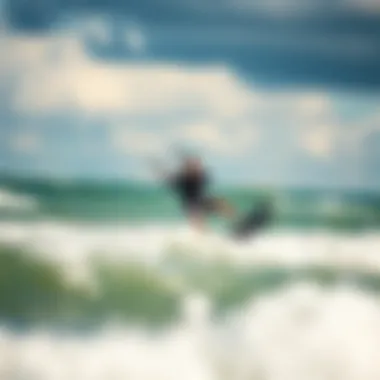

"Knowing how to read the signs is as important as knowing how to ride the waves."
When observing these maps, here are some key symbols to keep an eye on:
- Wind Arrows: Pointing in the direction wind is coming from, you’ll want your kite adjusted accordingly.
- Color Gradients: Warmer colors usually signify stronger winds or potential storms, so beware.
- Precipitation Icons: Rain or storm symbols indicate times to stay off the water for safety.
- Humidity Indicators: High humidity can affect your kite performance and personal comfort on the beach.
Interpretation Techniques
Once you have grasped the symbols, knowing how to interpret them is the next step. Start by looking at the overall picture. For instance, is the wind direction consistent across the map? If so, that generally suggests reliable conditions for kiteboarding. Conversely, a map littered with varied wind arrows signifies turbulence, likely making it harder to maintain control.
A few techniques to enhance your interpretation skills include:
- Focus on Local Observations: Comparing forecast maps with real-time conditions can sharpen your interpretation skills. If the map predicts a steady east wind, but you notice gusts or shifts as you’re out, adjust your strategy accordingly.
- Use Multiple Sources: Cross-referencing the weather forecast map with local weather services or apps tailored specifically for water sports can provide a clearer and more accurate read on conditions.
- Watch for Seasonal Trends: Patterns do repeat, particularly certain times of year. Keep track of past weather data to anticipate what might happen next. For instance, sometimes early spring might bring strong breezes that aren’t reflected in the forecast right away.
Understanding how to interpret a weather forecast map will empower kiteboarders to make informed decisions and enjoy optimal conditions on the water.
Impact of Weather on Kiteboarding
Understanding how weather impacts kiteboarding is pivotal for enthusiasts looking to enhance their experiences and ensure safety on the water. Weather conditions, particularly wind, temperature, and precipitation, dictate not just the feasibility of kiteboarding sessions, but also the overall performance of the riders. Analyzing these factors can differentiate between a thrilling day on the water and a regrettable mishap.
Wind Conditions and Kiteboarding Performance
Wind is the lifeblood of kiteboarding; without it, the sport simply wouldn't exist. Optimal wind conditions can elevate performance, providing the perfect lift and speed needed for various tricks and maneuvers. Too little wind, however, can leave riders struggling to gain momentum, while excessive wind poses risks of losing control and could lead to accidents.
When planning a kiteboarding session, it’s crucial to monitor not just how strong the wind is, but also its direction and consistency.
Factors to Consider:
- Wind Speed: Ideal kiteboarding wind generally ranges between 12 to 25 knots for most riders. Anything lower and you’re stuck on the beach; anything higher, and it can get chaotic. Different kites cater to various ranges, so knowing when to use what is key.
- Wind Direction: Offshore winds (blowing from land to sea) generally present the most significant challenges, particularly for beginners, since it can push kiteboarders away from the safety of the shore. Onshore winds (blowing from sea towards land) are much safer, allowing for an easier return.
- Stability: Consistent wind will help maintain a smooth kiteboarding experience. Gusty winds can create unpredictable challenges, pushing the kite up and then dropping it suddenly. A stable environment lets riders focus more on perfecting their techniques instead of worrying about the kite.
In essence, monitoring wind conditions via reliable weather resources and forecast maps ensures kiteboarders capitalize on ideal conditions while steering clear of potentially hazardous situations.
Safety Considerations
Safety isn’t just an option; it’s a necessity when it comes to kiteboarding. Weather plays a central role in ensuring riders remain safe while enjoying their time on the water. Here are some key considerations:
- Understanding Local Weather Patterns: Each region may exhibit unique weather traits that can impact sessions. Familiarizing oneself with local climate nuances, like sudden squalls or afternoon thunderstorms in the Gulf of Mexico, can be a game-changer.
- Precipitation Awareness: Rainy days can cause visibility issues or alter wind patterns abruptly. Stay abreast of any forecast that indicates rain and potentially postpone or modify plans on such days.
- Dangerous Conditions: It’s not only about the wind but also the factors like lightning, rip currents, or changes in tide. Awareness of all weather conditions assists in making informed decisions.
"Weather forecasting is not just a science; it’s an art that combines observation, knowledge, and intuition. Knowledge of weather dynamics can turn a typical ride into a safe and enjoyable experience."
Ultimately, prioritizing safety through keen attention to weather gives riders the freedom to focus on what they love most—kiteboarding—without the looming threat of nature’s unpredictable ways.
Best Practices for Planning Kiteboarding Sessions
When you’re off on an adventure in the Gulf of Mexico, timing is as crucial as picking the right gear. The weather can change faster than a wink, and kiteboarding demands more than just the right wind; it requires careful planning and smart decision-making. Understanding best practices for planning your kiteboarding sessions can separate a thrilling ride from a potentially hazardous situation.
Utilizing Weather Apps and Tools
Harnessing the power of technology can dramatically improve your kiteboarding experience. There are numerous apps and tools specifically designed to provide up-to-the-minute weather updates. Some of the most popular ones include Windy, NOAA Weather Radar, and OpenWeather. These applications not only give real-time data about wind speed and direction but also offer helpful forecasts for precipitation and temperature.
Think of it like having a personal meteorologist in your pocket. By checking these apps, you can spot trends and fluctuations that may not be apparent when just looking out at the water. It allows you to plan your sessions more intelligently, ensuring you're hitting the water when the conditions are right. Here are a few essential tips for using these tools effectively:
- Set Local Alerts: Most weather apps allow you to set alerts for specific weather conditions. This way, you get notified when the wind speed is ideal or if there's a sudden change in weather, keeping you informed no matter where you are.
- Explore Wind Maps: Many kiteboarding-specific apps will have interactive maps focusing on wind patterns. Learning to read these can greatly enhance your understanding of the area you'll be kiteboarding in.
- Compare Multiple Sources: It’s wise to cross-reference multiple apps to get a broader picture of what's going on. Each can offer slightly different data depending on their sources.
Understanding Local Conditions
Local knowledge is gold in the kiteboarding community. Familiarizing yourself with the specific characteristics of the Gulf of Mexico’s varied coastlines can offer insights that general weather forecasts simply can’t provide. Every kiteboarder should know some foundational aspects about the area they plan to kiteboard in:
- Spot-Specific Winds: Different locations can have unique wind patterns due to geographical features. For instance, coastal marshes might create gusty conditions, while urban setups can channel winds in specific directions. Observing how these local quirks affect wind is essential.
- Tides and Currents: Tidal patterns in the Gulf can greatly affect conditions. Kiteboarding during high tide might mean better waves, while low tide can reveal shallower waters, affecting your riding experience. It’s crucial to understand the timing of tides and how they interact with local currents.
- Seasonal Weather Changes: Different seasons can bring substantial changes, both in weather and sea conditions. From the humid summer months to the potential stormy weather in late summer, understanding these transitions can be your ace in the hole for planning successful sessions.
"Preparation is the key to success in any water sport, and kiteboarding is no different. Knowing your local environment is pivotal."
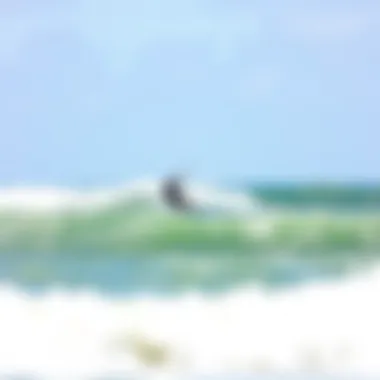

Keeping these considerations in mind while planning will help you maximize both safety and enjoyment during your kiteboarding escapades. The right weather, the right tools, and the right local knowledge make for a recipe that can elevate any kiteboarding session into an unforgettable experience.
Regional Variations in Weather Patterns
Understanding regional variations in weather patterns is key for kiteboarding enthusiasts looking to make the most of their time on the water. The Gulf of Mexico offers diverse conditions that can change dramatically from one area to another. This knowledge helps kiteboarders plan their sessions based on the specific weather traits of different coastal regions. Factors like wind direction, temperature, and storm activity can affect not only the quality of a kiteboarding session but also safety considerations.
East vs. West Gulf Coast
When comparing the East and West Gulf Coasts, kiteboarders will notice distinct differences in weather patterns that can significantly influence their experience.
- Wind Consistency: The East Coast, especially regions like Florida, generally benefits from more consistent trade winds. This steadiness is often ideal for kiteboarding. In contrast, the West Coast, while offering its own charm, may experience fluctuating weather patterns due to the varying topography and proximity to land masses.
- Temperature Variability: The East Coast tends to have milder winters, making it suitable for year-round kiteboarding. The West, conversely, may have colder snaps that can impact water temperatures and, subsequently, rider comfort.
- Unique Local Events: Each coast has its slew of unique weather events. For example, the East Coast can experience more tropical storms and hurricanes, while the West Coast might be influenced by some desert winds that create different kiteboarding conditions.
Understanding these differences is not just beneficial; it’s essential. Kiteboarders should consider these patterns while planning their adventures, ensuring they are appropriately prepared for the conditions they will encounter.
Tropical Storms and Hurricanes
The threat of tropical storms and hurricanes adds another layer of complexity to the weather patterns experienced in the Gulf of Mexico. These systems can develop quickly and bring unpredictable outcomes.
"Kiteboarding during a mild wind can be a joy, but during a storm, it’s a recipe for disaster."
- Predictive Awareness: It's vital for enthusiasts to stay aware of upcoming weather. Utilizing hurricane tracking resources, such as the National Hurricane Center (www.nhc.noaa.gov), is crucial. Being informed helps kiteboarders understand when to batten down the hatches and when to hit the waves.
- Post-Storm Conditions: Conversely, after a storm passes, the weather can lead to exceptional conditions, offering waves and winds that can be thrilling. However, the debris and water health may pose hidden dangers that one shouldn’t overlook.
- Safety Practices: It is paramount to ensure safety measures are in place. Diversifying your sources of weather information can make a difference. Use resources like NOAA (www.noaa.gov) alongside local websites and social media groups to gather firsthand accounts and updates from other kiteboarders.
Kiteboarding in the Gulf of Mexico is made richer by understanding its regional variations in weather patterns. By assimilating this knowledge, practitioners can enhance their safety, enjoyment, and performance on the water.
Case Studies of Past Weather Events
Analyzing past weather events is crucial for kiteboarders looking to navigate the complexities of the Gulf of Mexico. Understanding how previous weather patterns influenced kiteboarding conditions not only helps in anticipating future occurrences but also provides a better grasp on the safety measures necessary for a thrilling day out on the water. By delving into specific incidents, kiteboarders can learn how different weather variables interplay and impact their sport.
Analyzing Key Incidents
Consider the dramatic kiteboarding incident that took place during Hurricane Harvey in 2017. As rain poured and winds reached ferocious levels, many inexperienced kiteboarders ventured out, unaware of the impending dangers. The incident serves as a stark reminder of the unpredictable nature of the sea and the critical need for accurate weather forecasting. This case underlines the fact that local peculiarities—like sudden wind shifts or rapidly changing currents—can lead to situations that drastically differ from typical forecasts.
Another noteworthy event was the strong cold front in late January 2020 that swept through the Gulf. Experienced riders capitalized on the gusty winds, achieving exhilarating jumps that would otherwise be impossible. Yet, for those who misread the rapid drop in temperature or erroneously assessed wind fluctuations, the day turned dicey quickly. These incidents spotlight the necessity of reading weather patterns, understanding how wind speed and direction fluctuate with temperature, and always checking local advisories.
Learning from Historical Data
Diving into historical weather data presents immense value for those keen on kiteboarding in the Gulf. For instance, analyzing patterns from previous years around the same month can provide insights into expected wind speeds and precipitation levels. Historical records reveal that late summer often presents optimal conditions for kiteboarding, typically marked by steady winds and less rain.
A study on the frequency of tropical storms between 1995 and 2020 offers substantial evidence supporting this observation. With careful mapping, one can identify years when storms disrupted optimal conditions and correlate that with kiteboarding success during those periods. By isolating these climatic variables, kiteboarders can develop strategies tailored to the Gulf's quirks, ultimately enhancing both performance and safety.
"Knowing the weather means knowing the waters. History is not just for the books; it's a kiteboarder's best ally."
For further readings on weather patterns, consider visiting NWS Weather Forecasts or diving into archives from NOAA for historical data that could guide your kiteboarding adventures.
The End: Navigating the Gulf of Mexico Weather
Navigating the nuances of the Gulf of Mexico weather is essential not just for a successful kiteboarding session but also for ensuring the safety of participants. Understanding local weather forecasts can drastically alter the experience, enabling enthusiasts to select the best times for their sport while acknowledging potential risks. This section wraps up the critical elements discussed throughout the article and provides kiteboarders with insights they can carry into their future adventures.
Summarizing Key Insights
Throughout this exploration, several core components have emerged that are pivotal for kiteboarding enthusiasts:
- Seasonal Weather Variations: Recognizing the distinct seasonal shifts maintains awareness of changing conditions. For instance, summer may usher in consistent winds, while winter can invite unpredictable gales.
- Components of Weather Forecast Maps: Familiarity with temperature, wind direction, and humidity indicators equips riders with the knowledge to anticipate their kiteboarding conditions more accurately.
- Safety Considerations: Prioritizing safety by understanding local weather patterns and preparing for sudden weather changes is paramount. Being aware of tropical storm seasons can safeguard against unexpected incidents.
These key insights serve as guidelines, allowing kiteboarders to harness the powerful forces of nature rather than be at their mercy.
Future Trends in Weather Forecasting
Looking ahead, advancements in technology will likely enhance the precision of weather forecasts. Here are some possible trends worth noting:
- AI and Machine Learning: As artificial intelligence becomes more integrated into meteorological models, predictions may become increasingly accurate, providing real-time updates on wind and weather conditions.
- Mobile Apps and IoT Devices: The rising number of weather apps tailored specifically for kiteboarding, integrated with real-time weather sensors, will empower riders to make informed choices.
- Community-Based Reporting: Platforms like Reddit may further develop local reporting features, where kiteboarders can share firsthand experiences about recent conditions.
Ultimately, being proactive and aware of these trends helps kiteboarders harness the full potential of the Gulf's weather, ensuring that they ride with confidence and wisdom. Keeping an eye on evolving weather technology, along with staying informed on historical conditions will create a more enriching kiteboarding experience.
“The winds of change are always blowing; it's up to us to adjust our sails.”
The journey through understanding the Gulf of Mexico's weather is an ongoing endeavor, but the knowledge gathered will undoubtedly lead to more exhilarating and safe kiteboarding experiences. Each session on the water carries new lessons and opportunities to refine skills, turning knowledge into adventure.











